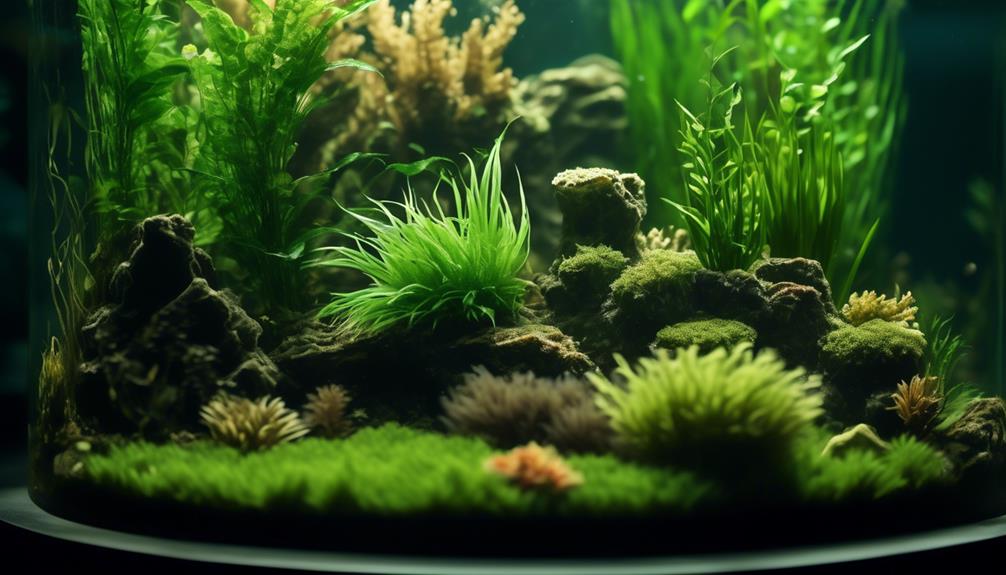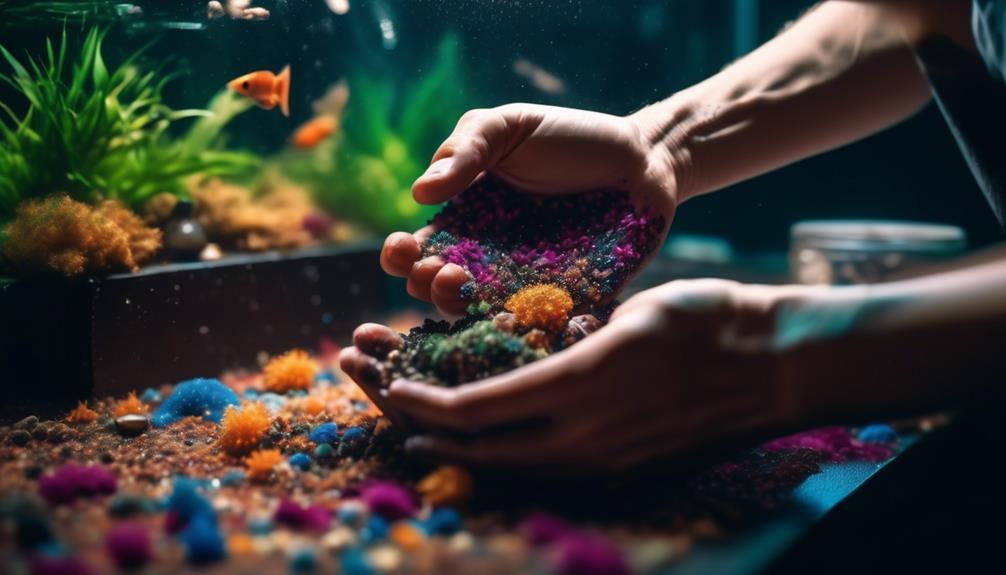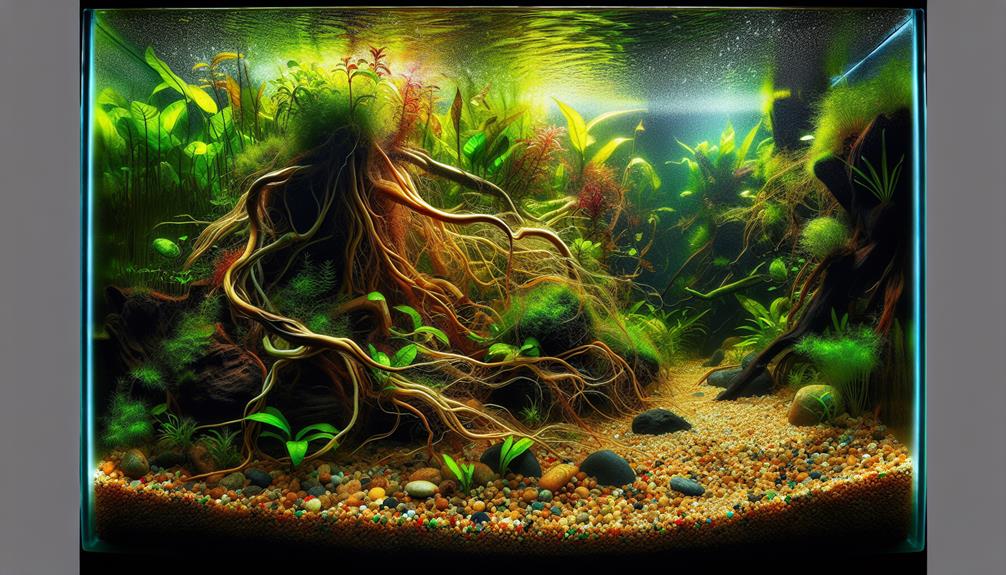Creating a thriving and visually stunning planted aquarium requires careful consideration of various factors, and one crucial aspect is the choice of substrate.
The right substrate can unlock the true potential of your aquatic plants, providing them with essential nutrients and anchoring them securely.
However, with so many options available, it can be overwhelming to determine which substrate is best suited to your aquarium.
In this discussion, we will explore the different types of substrates, their benefits, and how to properly prepare and maintain them for optimal plant growth.
By understanding the power of substrates, you will be on your way to creating a captivating aquatic landscape that will leave your fellow aquarists in awe.
Key Takeaways
- Nutrient-rich substrates provide essential nutrients for plants, promoting long-term plant health.
- Inert substrates like gravel or sand provide stability and a visually appealing environment for plants.
- When choosing a substrate, consider the pH and water hardness preferences of plants and fish, as well as the specific needs of the aquarium's inhabitants.
- Different types of substrates, such as gravel, sand, clay-based substrates, aquasoils, and crushed coral or shells, offer various benefits and can be tailored to suit different plant species and desired water parameters.
Nutrient-Rich Substrates
Nutrient-rich substrates play a crucial role in supporting the growth and vitality of aquatic plants in a planted aquarium. Organic soil, in particular, offers numerous benefits for plant health.
It contains essential nutrients that are vital for plant growth, such as nitrogen, phosphorus, and potassium. These nutrients are slowly released into the water, providing a steady supply for the plants. Furthermore, organic soil can lower the pH and water hardness, creating an environment that is more favorable for plant growth.
In comparison, inert substrates, such as gravel or sand, have few nutrients and rely on external supplementation through root tabs or liquid fertilizers. While stem, floating, and rhizome plants can thrive with inert substrates, nutrient-rich substrates offer a more comprehensive and sustainable solution for long-term plant health and vitality in a planted aquarium.
Inert Substrates
Inert substrates, such as gravel or sand, are characterized by their low nutrient content and reliance on external supplementation for plant growth in a planted aquarium. Despite their lack of inherent nutrients, inert substrates offer several benefits in low tech planted aquariums:
- Stability: Inert substrates provide a stable and consistent environment for plant roots, allowing them to anchor securely and grow efficiently.
- Aesthetic appeal: The natural colors and textures of gravel or sand can enhance the visual appeal of the aquarium, creating a beautiful and natural-looking habitat.
- Compatibility with low-tech setups: Inert substrates are ideal for low-tech planted aquariums that don't rely on CO2 injection or high-intensity lighting.
- Flexibility: With inert substrates, a wide range of plants, especially stem, floating, and rhizome plants, can thrive without the need for nutrient-rich substrates.
- Comparing root tabs vs. liquid fertilizers: Inert substrates can be supplemented with either root tabs or liquid fertilizers. Root tabs provide slow-release nutrients directly to the root zone, while liquid fertilizers offer more flexibility in adjusting nutrient levels throughout the water column. The choice depends on the specific needs of the plants and the aquarium setup.
Factors to Consider When Choosing Substrate

When selecting the substrate for a planted aquarium, several factors should be taken into consideration to ensure optimal plant growth and compatibility with the aquarium's inhabitants.
One important factor is the pH and hardness preferences of the plants and the fish. Some plants thrive in acidic or soft water conditions, while others prefer alkaline or hard water. It is crucial to choose a substrate that can help maintain the desired water parameters for the plants and fish.
Another factor to consider is the compatibility with bottom-dwelling fish. Some fish species, such as Corydoras and loaches, like to sift through the substrate for food. Therefore, it is important to choose a substrate that is not sharp or abrasive to avoid injuring these fish.
Types of Substrates for Planted Aquariums
There are various substrates available for planted aquariums, each with its own unique characteristics and benefits. When choosing a substrate for your planted aquarium, it is important to consider the specific needs of your plants and the overall aesthetic you wish to achieve. Here are five options to consider:
- Gravel: Gravel is a popular choice for planted aquariums due to its versatility and affordability. It comes in various colors and sizes, allowing for customization of the tank's appearance.
- Sand: Sand is another common substrate option, especially for aquariums with delicate plants or bottom-dwelling fish. It provides a natural look and allows for easy rooting and maintenance.
- Clay-based substrates: Clay-based substrates, such as laterite or clay balls, are rich in nutrients and promote healthy plant growth. They also help to stabilize pH levels and improve water quality.
- Aquasoils: Aquasoils are specifically designed for planted aquariums and provide a complete nutrient-rich environment for plants. They are ideal for demanding plant species and can enhance the overall health and vibrancy of your aquatic ecosystem.
- Crushed coral or shells: Crushed coral or shells are primarily used to raise pH and water hardness levels in aquariums. They are beneficial for plants that prefer alkaline conditions and can create a more natural habitat for certain fish species.
Tips for Preparing and Maintaining Substrate

To ensure optimal growth and health of your aquatic plants, it is crucial to properly prepare and maintain the substrate in your planted aquarium.
Choosing the right grain size is important as it can impact the overall look and functionality of the substrate. Smaller grains, such as sand, are ideal for delicate plants with fine roots, while larger grains, like gravel, provide better water circulation and prevent anaerobic conditions.
Additionally, using root tabs effectively can greatly enhance the nutrient content of the substrate. Root tabs are small fertilizing tablets that can be inserted directly into the substrate, providing a localized nutrient boost for root uptake.
Regularly monitoring and adjusting water parameters, as well as vacuuming the substrate to remove debris, are also essential for maintaining a healthy planted aquarium.
Frequently Asked Questions
Can I Use Regular Garden Soil as a Substrate in My Planted Aquarium?
Using regular garden soil as a substrate in a planted aquarium is not recommended. Garden soil may contain harmful chemicals and contaminants that can be detrimental to the health of aquarium plants and aquatic life.
What Is the Best Substrate for Carpeting Plants?
Carpeting plants thrive best in substrates that provide a stable base for root growth and allow for easy spreading. A substrate depth of at least 2-3 inches is recommended to ensure proper anchoring and nutrient uptake for carpeting plants.
How Often Should I Replace the Substrate in My Planted Aquarium?
Replacing substrate regularly in a planted aquarium is not necessary unless it becomes excessively dirty or depleted of nutrients. Using specialized aquarium substrate can provide long-lasting benefits, such as nutrient retention and pH stabilization.
Can I Mix Different Types of Substrates in My Aquarium?
Yes, you can mix different types of substrates in your aquarium, such as sand and gravel, to create a visually appealing layout. However, it's important to consider the specific needs of your plants and ensure proper nutrient distribution throughout the substrate.
Will Using a Nutrient-Rich Substrate Cause Algae Problems in My Aquarium?
Using a nutrient-rich substrate in a planted aquarium can provide essential nutrients for plant growth. However, it can also promote algae growth if not properly maintained. Regular water testing, proper lighting, and nutrient dosing can help prevent algae problems in a nutrient-rich substrate.
Conclusion
In conclusion, selecting the right substrate for a planted aquarium is crucial for the health and growth of aquatic plants.
Nutrient-rich substrates provide essential nutrients but require capping, while inert substrates can be converted into nutrient-rich substrates with root tabs.
Factors such as plant species requirements, pH and hardness preferences, and grain size and texture should be considered.
Different types of substrates, such as gravel, sand, clay-based substrates, aquasoils, and crushed coral or shells, offer various benefits for plant growth.
Proper preparation and maintenance of the substrate are vital for creating vibrant and thriving planted aquariums.

